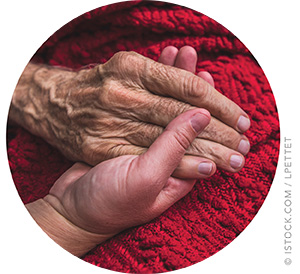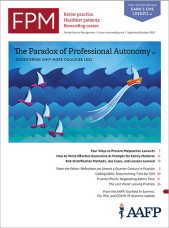
We need to get back to seeing our patients during their final days.
Fam Pract Manag. 2023;30(3):31
Author disclosure: no relevant financial relationships. No real patient names have been used.

As family physicians, we devote our careers to taking care of patients “from cradle to grave,” during some of their happiest and most difficult times. Over the years, they invite us into their lives, and we bond with their families. In turn, they ask about our kids and admire any new pictures or drawings we post on our exam room walls. Yet, during their final days, arguably the most important ones, we are frequently absent.
A TALE OF TWO PATIENTS
I had taken care of Jack for more than a decade. He was one of my favorites. When he turned 80, I told him that he was still one of the coolest guys I knew. Our conversations were frequently about his love for the beach and his support of local theater. Our clinic visits were both medical and social in nature. I also took care of his wife before she passed away from metastatic melanoma. His daughter and granddaughter remain my patients to this day.
Jack was diagnosed with primary biliary cirrhosis decades ago. But like many patients, his daily ursodiol kept the disease under control — that is, until his liver could not handle all of the years of subacute damage, which finally led to liver failure. He began to experience encephalopathy and confusion. He had problems with balance and frequent falls. There was some discussion of vascular dementia. During one visit, I could tell that Jack was not able to recall my name. He had always called me Adam.
His daughter managed his care as best as one could. We had all of the appropriate conversations as Jack got sicker, from power of attorney to hospice care. I saw Jack every few months during his final years.
A couple months after our last visit, I suddenly received a notification from our local hospice group. Jack had passed away. My jaw dropped. Before I picked up the phone to call his daughter to express my condolences, I noticed that the date of his passing had actually been two weeks prior. Why hadn't hospice notified me earlier? I spoke to his daughter, who understandably thought I had been made aware. I felt terrible that I couldn't reach out to his family sooner. I never got to say goodbye.
The circumstances were a little different with Jane. She was a wonderful 90-year-old woman who had been a cheerleader in college and carried that energy into her later years. Her daughter and two granddaughters took care of her beautifully at home. Being Jane's doctor made me feel like a family physician from decades past. She and her family had my cell phone number for any emergencies, but they used that access judiciously.
Over the years, Jane's body started to slow down. She exhibited more confusion. She dealt with some recurrent infections that landed her in the hospital. With the onset of atrial fibrillation, her heart started to give out. The week before her passing, Jane fell and broke her arm. Due to her weakness and cardiac condition, she was admitted to the hospital. On her last day, her daughter called and told me that she probably only had hours to live. I intended to go see her during my lunch hour before I started seeing my afternoon patients. But my last patient of the morning required more time and attention than I had anticipated, so I couldn't go to the hospital until the end of the day. I received another call shortly after lunch. Jane had passed away. Her granddaughter was holding her hand at her bedside, telling her it was OK to let go. She gave one last breath and fell asleep. Again, I never got to say goodbye.
CONTRIBUTING FACTORS
Families have to balance many things during those difficult final days: informing family and friends, dealing with funeral arrangements and financial issues, and managing their own grief. They may be seeing a number of physicians during that time, especially if the patient is admitted to the hospital. Calling their dying loved one's primary care doctor is understandably not always at the top of the list. Families may assume the medical team or hospice group will keep us in the loop, but that is often not the case.
Another complicating factor is that the majority of primary care physicians now practice solely in the outpatient setting. With the advent of hospitalists, few of us round in the hospital. Our days are spent running the hamster wheel of busy schedules full of 15-minute visits, while our nights are frequently devoted to “pajama time” — the completion of EHR tasks or notes we could not get to during the day. Once in a while, we may pay a “social visit” to one of our patients in the hospital, but we are largely outsiders in the care of the patient at that point. Even if we do get notified that death is imminent, it's usually hard to break away from the office.
A BETTER WAY
I want to get back to helping my patients during their dying moments. As challenging as those times are, they are also the most rewarding. I want the opportunity to be present. That might be easier to accomplish in certain practice settings, like concierge medicine or direct primary care. But even in traditional practice, surely we can start by communicating to our patients and our colleagues that these final moments are truly meaningful to many of us, and that we wish to be notified when those last minutes are upon us.
That's what happened with Rebecca. She was an energetic, funny, tell-it-like-it-is woman in her 50s. When she was diagnosed with lung cancer, she was not afraid and told me she was going to kick its butt. And she did, until a couple years later when the cancer came back with metastasis to the brain. She gained 50 pounds on steroids used to reduce the inflammation in her brain. She had a couple of strokes. During her last days, she went to an inpatient hospice facility overlooking a beautiful garden. I got a message late one day that she didn't have much longer, so I drove to see her.
I will never forget that visit. Despite being on pain medication, she had her full wits about her. We laughed and told stories. Instead of being angry or sad, she was joyful. She kept telling me she was about to go join “the big party in the sky” and they were waiting for her. I spent close to an hour with her. I gave her one last big hug. Rebecca passed away two days later.
The interesting thing is that, a few months prior, Rebecca had sent me a Christmas card at the office. It was placed on my workstation, but by the end of the day, it had disappeared. I looked everywhere but could not find it. I felt awful and later confessed to her that I had somehow misplaced the card. It was one of the things we laughed about during that final visit.
A couple weeks after Rebecca's passing, after a stressful day, I opened up one of the drawers at my workstation and spotted a red envelope jammed in the back as if it had somehow slipped in and gotten stuck. It was Rebecca's Christmas card. The card expressed her gratitude for my care, appreciation for our friendship, and a peaceful outlook on her inevitable death. There was humor and laughter in her words as well.
I guess she just wanted to make sure she got to say goodbye.
